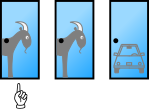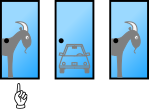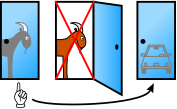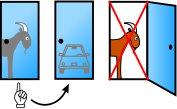User talk:Gerhardvalentin/Bayes' rule
Proposal 1[edit]
Decision tree[edit]
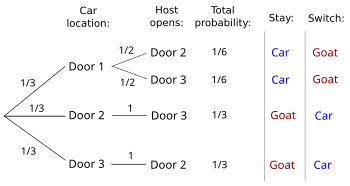
The conditional probability of winning by switching given which door the host opens can be determined referring to the expanded figure below, or to an equivalent decision tree as shown to the right (Chun 1991; Grinstead and Snell 2006:137-138), or formally derived as in the mathematical formulation section below. For example, the player wins if the host opens Door 3 and the player switches and the car is behind Door 2, and this has probability 1/3. The player loses if the host opens Door 3 and the player switches and the car is behind Door 1, and this has probability 1/6. These are the only possibilities given host opens Door 3 and player switches. The overall probability that the host opens Door 3 is their sum, and we convert the two probabilities just found to conditional probabilities by dividing them by their sum. Therefore, the conditional probability of winning by switching given the player picks Door 1 and the host opens Door 3 is (1/3)/(1/3 + 1/6), which is 2/3.
This analysis depends on the constraint in the explicit problem statement that the host chooses uniformly at random which door to open after the player has initially selected the car (1/6 = 1/2 * 1/3). If the host's choice to open Door 3 was made with probability q instead of probability 1/2, then the conditional probability of winning by switching becomes (1/3)/(1/3 + q * 1/3)). The extreme cases q=0, q=1 give conditional probabilities of 1 and 1/2 respectively; q=1/2 gives 2/3. If q is unknown then the conditional probability is unknown too, but still it is always at least 1/2 and on average, over the possible conditions, equal to the unconditional probability 2/3.(Morgan et al. 1991)
And, if all doors are initially equally likely to hide the car and the host is equally likely to open either door when he has a choice, the chance that the switching will give the car cannot depend on which door was chosen by the player and which door was opened by the host.(Morgan et al. 1991)
Bayes' theorem in odds form: Bayes' rule[edit]
Proof using Bayes' rule. Bayes' rule states that posterior odds equal prior odds times likelihood ratio. Initially, the odds that Door 1 hides the car are 2 to 1 against. If the car is actually behind Door 1 (the door chosen by the guest), the chance the host will open Door 3 is 0.5 (both doors are equally likely to be opened when the host has a choice). If on the other hand the car is not behind Door 1, it is equally likely to be behind Door 2 or Door 3, and the host is forced to open the only door of this pair which has a goat behind it. Also in this case, therefore, the chance he will open Door 3 is 0.5. The likelihood ratio for and against the car being behind Door 1, provided by the "information" that the host opens Door 3, is therefore 0.5/0.5=1. – So the host's action gives the guest no information at all about whether or not the car is behind Door 1. The posterior odds that the car is behind Door 1, given the information that Door 3 is open, remains 2 to 1 against. Of course, the odds on the car being behind Door 3 do change - they become zero! The odds on the car being behind Door 2 also change - they become 2 to 1 in favour (Rosenthal, 2005a; Rosenthal, 2005b; Gill, 2011b).
Bayes' theorem[edit]
Bayes' theorem relates the conditional and marginal probabilities of events A and B, provided that the probability of B does not equal zero:
where denotes the conditional probability of given .
For the MHP, let event A be the car is behind the initially selected door (say, for example, door 1). The probability of event A, written P(A), is 1/3 because each door is equally likely. Let event B be the host reveals a goat behind one of the other two doors. There are two goats, so at least one of the remaining doors will hide a goat. From the rules, the host will not reveal a car. Consequently, the probability that the host reveals a goat behind one of the other two doors, P(B), is 1. Similarly, P(B | A), the probability of event B (the host reveals a goat) given A (the car is behind the initially selected door) is also 1. Substituting the numbers in Bayes' formula gives
The formula tells us that the conditional probability that the car is behind the initially selected door is unchanged at 1/3 (i.e., the same probability before the host revealed the goat). That also means that switching is advantageous because the probability that the remaining door has the car is 2/3.
For an application of Bayes theorem using distinguished doors, see Gill, 2002 and Henze, 1997.
Alternative derivations[edit]
...
...
Proposal 2[edit]
Bayes' theorem in odds form: Bayes' rule[edit]
Proof using Bayes' rule. Bayes' rule states that posterior odds equal prior odds times likelihood ratio. Initially, the odds that Door 1 hides the car are 2 to 1 against. If the car is actually behind Door 1 (the door chosen by the guest), the chance the host will open Door 3 is 0.5 (both doors are equally likely to be opened when the host has a choice). If on the other hand the car is not behind Door 1, it is equally likely to be behind Door 2 or Door 3, and the host is forced to open the only door of this pair which has a goat behind it. Also in this case, therefore, the chance he will open Door 3 is 0.5. The likelihood ratio for and against the car being behind Door 1, provided by the "information" that the host opens Door 3, is therefore 0.5/0.5=1. – So the host's action gives the guest no information at all about whether or not the car is behind Door 1. The posterior odds that the car is behind Door 1, given the information that Door 3 is open, remains 2 to 1 against. Of course, the odds on the car being behind Door 3 do change - they become zero! The odds on the car being behind Door 2 also change - they become 2 to 1 in favour (Rosenthal, 2005a; Rosenthal, 2005b; Gill, 2011b).
Alternative arguments[edit]
The solution in this section takes explicit account of which door was opened by the host: Door 2 or Door 3 - in order to argue that this does not change the answer. Moreover, in this solution "probability" is used in the ordinary daily-life Bayesian or subjectivist sense: that is to say, probability statements are supposed to reflect the state of knowledge of one person. To be specific, that person will be a guest on the show who initially knows no more than the following: he'll choose a door; the host (who knows where the car is hidden) will thereupon open a different door revealing a goat and make the offer that the guest switches to the remaining closed door. For our guest, initially all doors are equally likely to hide the car. Moreover, if he chooses any particular door, and if the car happens to be behind that particular door, then as far as our guest is concerned the host is equally likely to open either of the other two doors.
The guest initially chooses door number 1. Initially, his odds that the car is behind this door are 2 to 1 against: it is two times as likely for him that his choice is wrong as that it is right.
The host opens one of the other two doors, revealing a goat. Let's suppose that for the moment, the guest doesn't take any notice of which door was opened. Since the host is certain to open a door revealing a goat whether or not the car is behind Door 1, the information that an unspecified door is opened revealing a goat does not change the guest's odds that the car is indeed behind Door 1; they are still 2 to 1 against.
Now here comes the further detail which we will take account of in this solution: the guest also gets informed which specific door was opened by the host - let's say it was Door 3. Does this piece of information influence his odds that the car is behind Door 1? No: from the guest's point of view, the chance that the car is behind Door 1 can't depend on whether the host opens Door 2 or Door 3 - the door numbers are arbitrary, exchangeable.
Therefore, also knowing that the host opened specifically Door 3 to reveal a goat, the guest's odds on the car being behind his initially chosen Door 1 still remain 2 to 1 against. He had better switch to Door 2.
Explicit computations[edit]
Students of probability theory might feel uneasy about the informality (the intuitive nature) of the last step. Ordinary people's intuition about probability is well known to be often wrong — after all, it is ordinary intuition which makes most people believe there is no point in switching doors! To feel more secure, students of probability theory might consider the mathematical concept of symmetry and use the law of total probability to show how symmetry leads to statistical independence between the events "Car is behind Door 1" and "Host opens Door 3", when it is given that the guest chose Door 1. Alternatively, they might like to explicitly use Bayes' rule: posterior odds equals prior odds times likelihood ratio. They just have to check that under the two competing hypotheses (whether or not the car is behind the door chosen by the guest, Door 1), the fact that it is Door 3 (rather than Door 2) which gets opened by the host has the same probability 1/2.
For some readers, numbers speak louder than words. The following table should be self-explanatory.
| ||||||||||||||||||||||||||||||||||||||||||||||||
We observe that the player who switches wins the car 2/3 of the time. We also see that Door 3 is opened by the host 1/2 = 1/6+1/3 of the time (row 2 plus row 3), as must also be the case by the symmetry of the problem with regard to the door numbers — either Door 2 or Door 3 must be opened and the chance of each must be the same, by symmetry.
Winning by switching in combination with Door 3 being opened occurs 1/3 of the time (row 3). The conditional probability of winning by switching, given Door 3 is opened, is therefore (1/3)/(1/2)=2/3. Since this is the same as the overall chance 2/3 of winning by switching, we see that knowing the identity of the opened door doesn't change the chance of winning by switching. Not only does the switcher win 2/3 of the time, he also wins 2/3 of the time when Door 3 is opened by the host, and 2/3 of the time when Door 2 is opened by the host.
In other words, the combined chance of winning by switching and Door 3 (rather than Door 2) being opened, 1/3, equals the product of the separate chances of "the car being behind the other door", 2/3, and "host opens Door 3", 1/2. Whether or not the car is behind the door not opened by the host is statistically independent of whether the host opens Door 2 or Door 3.
This last fact could have predicted in advance, by the symmetry of the problem. The guest may simply ignore the door numbers: they do not change his chances of winning by staying or by switching.
...
...

